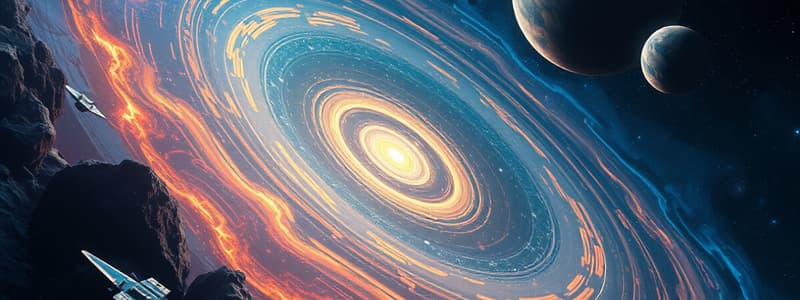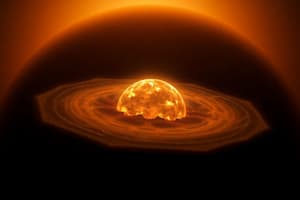Podcast
Questions and Answers
The solar system evolved from a ______ that disintegrated due to the fall of its own gravity.
The solar system evolved from a ______ that disintegrated due to the fall of its own gravity.
nebula
Matter began to move in a giant circular manner as the cloud continued to spin and contract, forming a disk with a ______ in the middle.
Matter began to move in a giant circular manner as the cloud continued to spin and contract, forming a disk with a ______ in the middle.
lump
The center contained high energy causing ______ reactions.
The center contained high energy causing ______ reactions.
nuclear
The disk edge emerged much cooler than the center due to the great distance from the ______.
The disk edge emerged much cooler than the center due to the great distance from the ______.
A ______ is a chunk of rock that orbits the sun.
A ______ is a chunk of rock that orbits the sun.
A ______ is a cosmic snowball of rocks, dusts, and frozen gases that grows tails as it approaches the sun.
A ______ is a cosmic snowball of rocks, dusts, and frozen gases that grows tails as it approaches the sun.
Similar to planet Uranus and Neptune, the ______ planet is known as a gaseous planet.
Similar to planet Uranus and Neptune, the ______ planet is known as a gaseous planet.
Konstantin Batygin and Mike Brown are researchers of the ______.
Konstantin Batygin and Mike Brown are researchers of the ______.
Flashcards are hidden until you start studying
Study Notes
Nebular Hypothesis
- Solar system formation traces back 4.5 billion years to a nebula disintegrating under its own gravity.
- The initial cloud comprised light elements, with trace amounts of heavier ones.
- Gravity-induced contraction led to denser atom formation through atomic clumping.
- Matter circulated in a massive whirl, resulting in a flattened disk with a central lump as the cloud continued to spin.
- Approximately 50 million years of high energy buildup in the center sparked nuclear reactions.
- The Sun and disk cooled down within a few thousand years; outer disk temperatures were significantly lower due to distance.
- Temperature variations led to the solidification of materials into various types: dust-like particles, rocky dust, and icy particles with water and frozen gases.
- Planet formation took around 500 million years in total.
Definition of Terms (Space Objects)
- Asteroid: A rocky fragment orbiting the sun.
- Comet: A "cosmic snowball" made of rock, dust, and frozen gases; develops a tail when near the sun.
- Meteor: Referred to as a "shooting star," this is a small debris piece entering a planet's atmosphere, leaving a bright tail.
- Meteorites: Fragments of meteors that survive passage through the atmosphere and reach the ground.
- Planet: A substantial celestial body that revolves around the Sun within the solar system.
- Moon: Also called a satellite, it is a solid body, some possessing an atmosphere, formed from gas discs surrounding planets.
Ninth Planet
- Known as "Planet Nine," it is akin to Uranus and Neptune, categorized as a gaseous planet.
- Evidence for its existence comes from tracing its highly elongated orbit in the outer solar system.
- Researchers Konstantin Batygin and Mike Brown are prominent figures in the search for Planet Nine.
Studying That Suits You
Use AI to generate personalized quizzes and flashcards to suit your learning preferences.





